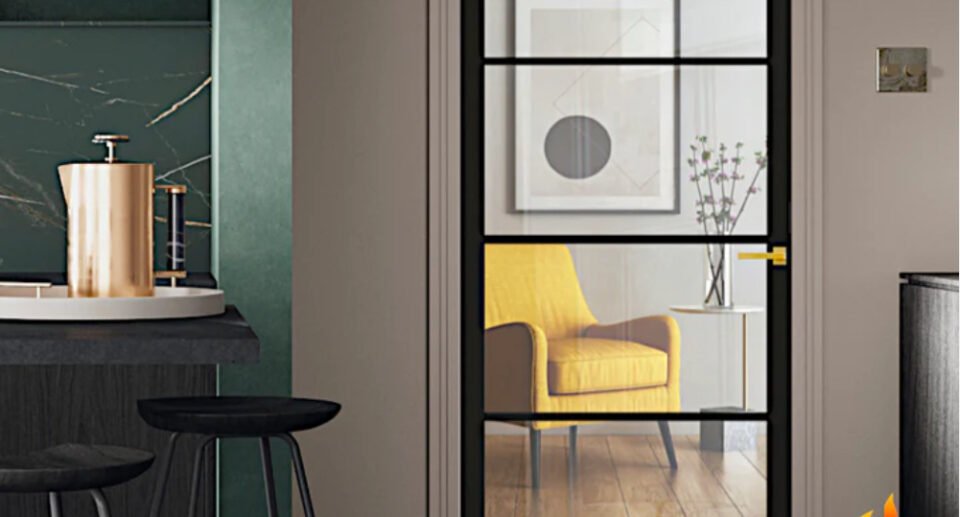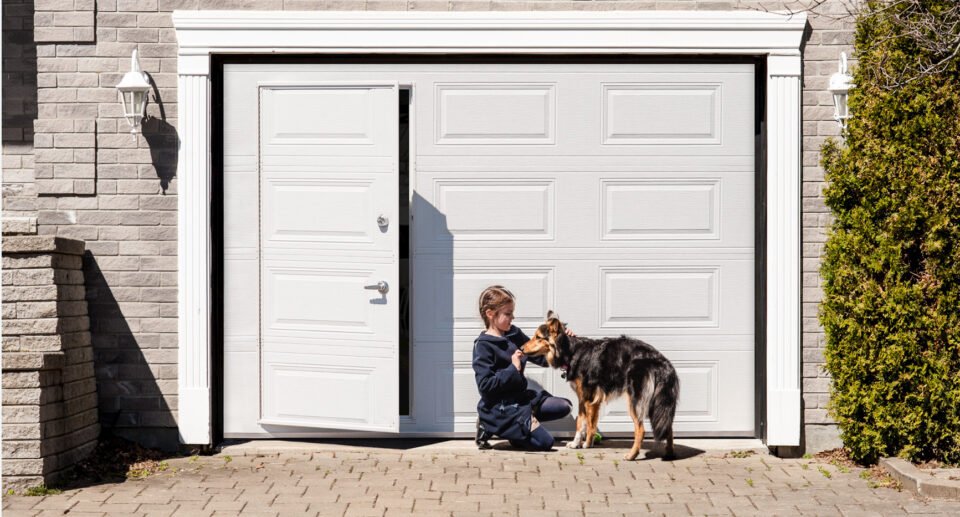Fire Door Regulations: Everything You Need to Know

Many people are unsure of the regulatory implications when it comes to installing internal fire doors in their homes or businesses.
To address these concerns we have compiled an easy-to-understand guide to fire door regulations. This guide aims to provide definitive answers to the most frequently asked questions about fire doors, including their legal requirement, the number of doors required in a building, the rooms that need fire doors, and more.
What is a fire door?
Fire doors are designed to prevent the spread of fire and smoke between different areas of a building. They are constructed using materials that offer greater fire resistance than conventional doors, and are thicker than standard internal doors – usually around 44mm in thickness. Fire doors are also designed to provide a tight fire seal between the door and the frame, so there will be a fire-resistant intumescent strip at the bottom of the door and around the sides.
How to tell if your door is a fire door
It is important to know if your door is a fire door, as they are required in certain areas of a building for safety reasons. The best way to tell if your door is a fire door is to look at the top edge of the door leaf. There will usually be a certification label showing the door’s fire safety rating. FD-30 is the most common rating, which means that the door can withstand fire for at least 30 minutes.
If in doubt, open the door up. If it is around 10mm thicker than your other internal doors with a fuzzy intumescent strip running along its circumference, it will be a fire door. There is also usually a red and yellow coloured plug within the door.
What does FD30-rated mean?
FD-30 is a fire certification assigned to fire doors by their manufacturers. If a door is FD-30 rated, it means that the door has passed the fire testing requirements laid out in BS 476-22:1987 and BS EN 1634-1:2014. As such, it is guaranteed to keep harmful fire and smoke at bay for a minimum of 30 minutes. Fire doors may also have other ratings, such as FD-60, which means that the door can withstand fire for at least 60 minutes.
In addition to the above, fire doors may also have other features, such as self-closing devices, air transfer grilles, smoke seals, and intumescent strips. It is important to ensure that all of these features are in good working order to ensure that the fire door can function properly in the event of a fire.
Are fire doors a legal requirement?
Fire doors are an essential part of fire safety in buildings, and they are subject to legal requirements in the UK. The legal requirements for fire doors vary depending on the type of building and its use, and they are set out in various pieces of legislation.
Are fire doors a legal requirement in flats?
In multi-occupied residential buildings in England, the Fire Safety (England) Regulations 2022 made it a legal requirement for responsible persons to ensure that all habitable rooms, including those in flats, have a fire door that leads onto a stairwell. However, not all doors in a flat are required to be fire doors. The only legal requirement is that a fire door be used for the front door, where the apartment is connected to communal areas such as stairwells or corridors.
When are fire doors required in a commercial building?
Fire doors are legally required for all internal doors that lead to communal corridors and stairways in commercial or public buildings. This is to ensure that they can provide an unobstructed escape route for occupants while ensuring that access to emergency exits is not impeded by fire. The Regulatory Reform (Fire Safety) Order 2005 requires that a fire risk assessment process be carried out for all commercial buildings, and this should include an assessment of the need for fire doors.
How many fire doors are required in a building?
There is no legal requirement for a specific number of fire doors in a building. However, commercial and public buildings must have more than one fire exit wherever possible to ensure adequate protection. As a result, fire-rated doors are required for doors leading from communal areas to facilitate safe fire exits. The minimum requirement for fire doors in a building is determined by the building’s fire risk assessment.
What Rooms Require Fire Doors?
According to regulations, a fire door is only necessary if it leads out from a habitable room onto a stairwell or corridor. This is only applicable for apartments with communal access and new or recently refurbished properties. However, there are no restrictions on installing fire doors in other rooms. It may be wise to have fire doors leading to kitchens or garages where combustion occurs. This can help reduce the risk of fires, smoke, or carbon monoxide poisoning in the home. Effective compartmentation is key in blocks of flats, and flat entrance doors and common parts should be considered. Proper ventilation is also important.
How often should fire doors be checked?
It is recommended that fire doors should be checked every six months to ensure that they are in good condition and fit for purpose. Regular checks on fire doors are essential, just like smoke alarms and fire extinguishers. Although there is no legislation for checking fire doors in domestic properties, public and commercial buildings are required to check their fire doors regularly.
Under Article 17 of the Regulatory Reform (Fire Safety) Order 2005 (RRO/FSO), it is a legal requirement for fire doors to be correctly installed and adequately maintained by a competent person. Regular checks and maintenance are necessary to ensure that fire doors are functioning correctly and to identify any damage, wear and tear, or faults that could affect their effectiveness in the event of a fire.
It is recommended that quarterly checks are carried out on fire doors to identify any faults or damage that may have occurred due to tamper or wear and tear. Annual checks should also be carried out by a competent person to ensure that the fire doors are still fit for purpose and comply with current regulations. Regular inspections and maintenance of fire doors are essential to ensure that they are functioning correctly and provide the necessary protection in the event of a fire.
Do You Need to Be Qualified to Fit Fire Doors?
Although there is no official requirement for domestic fire doors to be professionally fitted, it is recommended that fire doors be installed and tested by a trained and competent specialist. Commercial and public buildings must ensure that fire doors are installed by a competent person under Article 17 of the Regulatory Reform (Fire Safety) Order 2005 (RRO/FSO).
There is no single official accreditation that is necessary to install fire doors. However, some organisations such as The British Woodworking Federation Group offer accredited fire door installation courses. It is essential that whoever fits the fire door has the necessary knowledge and expertise to ensure that the door is fitted correctly and that it meets the relevant standards.
Can Fire Doors Be Propped Open?
Fire doors are designed to prevent smoke and fire from spreading to communal or inhabited areas of a building. Therefore, it is crucial to keep them closed at all times. Propping open a fire door in a public or commercial property is not technically illegal. However, it can make a company liable for injury or loss of life and will invalidate the insurance policy.
It is essential to ensure that fire doors are closed properly, and there are no obstructions preventing them from closing. The only exception to this is doors that have a retainer fitted. These retainers automatically close fire doors when a fire alarm is triggered.
Fire doors are designed to last for a specific period, and their certification will show how long they are designed to last in the event of a fire. For instance, FD30-rated doors (the most common fire door) will last for 30 minutes, FD60 for 60 minutes, FD90 for 90 minutes, and FD120 for 120 minutes. It is crucial to check the certification to ensure that the fire door is suitable for its intended purpose.
It is vital to remind residents and staff not to prop open fire doors as this can compromise their effectiveness in the event of a fire. Fire doors play a crucial role in keeping people safe, and it is essential to ensure that they are always closed when not in use.
What fire doors do I need?
When it comes to fire doors, it’s important to ensure that you have the right type for your property and that they meet the necessary regulations. In the UK, fire door regulations require that fire doors are regularly checked to ensure that they are in efficient working order.
To ensure that you have the right fire doors for your property, it’s important to consider factors such as the size of the door, the type of building and the level of fire resistance required.
When selecting fire doors, it’s essential to choose from a selection of tested and certified doors that meet the necessary regulations. This will ensure that your property is adequately protected in the event of a fire.
Frequently Asked Questions
What are the current legal requirements for installing fire doors in domestic properties in the UK?
The current legal requirements for installing fire doors in domestic properties in the UK are outlined in the Fire Safety (England) Regulations 2022. It is a legal requirement for responsible persons of all multi-occupied residential buildings in England with a floor above 11 metres to install fire doors that meet the minimum standards set out in the regulations.
How have the fire door regulations changed in the recent 2023 update?
The Fire Safety (England) Regulations 2022 updated the fire door regulations in England. The regulations made it a legal requirement for responsible persons to install fire doors in all multi-occupied residential buildings in England with a floor above 11 metres. The regulations also set out the minimum standards that fire doors must meet to comply with the regulations.
What are the minimum standards a fire door must meet to comply with UK regulations?
Fire doors must meet the minimum standards set out in the Fire Safety (England) Regulations 2022 to comply with UK regulations. The regulations state that fire doors must have a minimum fire resistance of 30 minutes, be self-closing, and have smoke seals. The regulations also specify the requirements for the gaps and seals on fire doors to ensure compliance.
Fire doors should be kept what at all times?
Fire doors should be kept closed at all times unless they are being used for access or egress. This is to prevent the spread of fire and smoke through the building.
What are the requirements for the gaps and seals on fire doors to ensure compliance?
The gaps and seals on fire doors must meet the requirements set out in the Fire Safety (England) Regulations 2022 to ensure compliance. The regulations state that the gap between the door and the frame must be no more than 4mm, and the gap between the bottom of the door and the floor must be no more than 10mm. The seals on the door must be able to expand in the event of a fire to prevent the spread of smoke and fire.
What are the essential components that a fire door must have to meet safety regulations?
To meet safety regulations, fire doors must have essential components. These include a door leaf, frame, intumescent strips, smoke seals, hinges, and a door closer. These components work together to ensure that the fire door can resist fire and smoke. They also prevent the spread of fire through the building.

Hello, I’m Keith Jones. I’m the author and head of content here of door and window guide. I’ve been in the window and door industry for over 10 years in the UK and North America. I’ve had quite a few roles during my career mainly in Worldwide sales. I’m now semi retired so I thought I’d put my knowledge to good use educating people about all they might need to know about door and window related topics.






